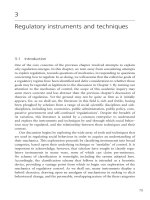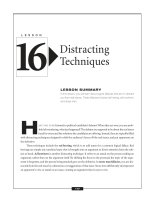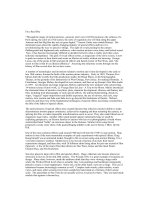Distracting Techniques
Bạn đang xem bản rút gọn của tài liệu. Xem và tải ngay bản đầy đủ của tài liệu tại đây (114.92 KB, 14 trang )
H
AVE YOU EVER
listened to political candidates’ debates? When they are over, you are prob-
ably left wondering, what just happened? The debates are supposed to be about the real issues
faced by voters and the solutions the candidates are offering. Instead, they are typically filled
with distracting techniques designed to shift the audience’s focus off the real issues, and put opponents on
the defensive.
These techniques include the red herring, which is an odd name for a common logical fallacy. Red
herrings are simply any unrelated topic that is brought into an argument to divert attention from the sub-
ject at hand. Ad hominem is another distracting technique. It refers to an attack on the person making an
argument, rather than on the argument itself. By shifting the focus to the personal, the topic of the argu-
ment is forgotten, and the person being attacked goes on the defensive. In straw man fallacies, you are dis-
tracted from the real issue by a distortion or exaggeration of that issue. Straw men deliberately misrepresent
an opponent’s view or stand on an issue, creating an argument that is easy to win.
LESSON
Distracting
Techniques
LESSON SUMMARY
In this lesson, you will learn about logical fallacies that aim to distract
you from real issues. These fallacies include red herring, ad hominem,
and straw man.
16
117
While these distracting techniques are usually
easy to spot, they can be challenging to deflect. If one
is aimed at you, it’s critical to understand how it works
and how to take it apart so attention can be refocused
onto the real issue.
Red Herring
In an argument, a red herring can be any diversion that
distracts attention from the main issue. The name of
this distracter comes from a very strong-smelling cured
fish that was once used, variously, to distract blood-
hounds from the scent of escaping prisoners, or to dis-
tract hunting dogs from the trail of their prey.
The diversion usually takes the form of an irrel-
evant topic, which is designed to lead attention away
from the real issue and onto another topic. Typically,
someone who is on the defensive end of an argument
will use a red herring to change the subject from one
he is not comfortable with to one he feels he can win
with. A red herring fallacy looks like this:
1. There is discussion of issue A.
2. There is introduction of issue B (irrelevant to
issue A, but pretending to be relevant).
3. Issue A is forgotten and issue B becomes the
focal point.
Example
“Nuclear power is a necessity, even
though it has the potential to be danger-
ous. You know what is really dangerous,
though? Bathtubs. More people die in
accidents in their bathtubs every year than
you can imagine.”
Where is the red herring? Here is issue A: Nuclear
power is a necessity, even though it has the potential to
be dangerous. Next, issue B is introduced, which is not
relevant to issue A: Bathtubs are really dangerous. Then,
we hear more about issue B, and issue A is forgotten.
The speaker in this example may be uncomfort-
able discussing the potential dangers of nuclear power
and/or she wants to lessen their impact by talking
instead about the dangers of bathtubs. In either case,
she has used a red herring, a distracter, to leave the issue
she does not want to talk about. Simply, she has
changed the subject.
Red herrings work well when the distracter is
something that many people will agree with, or when
it seems to be closely related to the issue at hand. In the
first instance, you might throw in a comment about
how no one likes paying higher taxes or working longer
hours. Who would disagree? For example, “Our new
boss does seem to be getting the job done. But, how
about those longer hours? Are you happy about your
new work schedule? You have less time with your fam-
ily and you are not making any more money than
before.” The speaker here diverted attention away from
the good job being done by his boss, and onto the topic
of longer working hours.
Practice
What is the red herring in the following argument?
How might the argument continue without it?
It is a great idea to eliminate free checking
from our bank services. There is a lot of
support for it. You know, if the bank does
not meet its profit goals, we could be out
of a job.
__________________________________________
__________________________________________
__________________________________________
__________________________________________
__________________________________________
–
DISTRACTING TECHNIQUES
–
118
Answer
The red herring is the last line, “if the bank does not
meet its profit goals, we could be out of a job.” The
argument is supposed to be about the elimination of
free checking. Instead, the speaker goes off track by
inserting the uncomfortable idea of job losses. It could
be an effective argument if reasons were given for the
“great idea.”
Ad Hominem
Another common distraction fallacy is the ad hominem
(Latin for “against the person”). Instead of arguing
against a topic, the topic is rejected because of some
unrelated fact about the person making the argument.
In other words, the person who makes a claim
becomes the issue, rather than the claim he or she was
making. If you are not thinking critically, you might be
persuaded by such an argument, especially if you agree
with the information given about the personality.
For instance, a celebrity athlete is endorsing a car
model, explaining its great gas mileage and service
record. Your friend interrupts, saying, “who would
believe anything that jerk says? He can’t throw a ball to
save his life.” What if you agree that his ability as an ath-
lete is lousy? It might make it more difficult for you to
spot your friend’s illogical distracter. The athlete’s abil-
ity to throw a ball is not important here. What is impor-
tant are the facts about the car.
Ad hominem arguments look like this:
1. Person A argues issue G.
2. Person B attacks person A.
3. Person B asserts that G is questionable or false.
Ad hominem arguments are made in three ways,
all of which attempt to direct attention away from the
argument being made and onto the person making it.
1. Abusive: an attack is made on the character or
other irrelevant personal traits of the opposi-
tion. These attacks can work well if the person
being attacked defends himself and gets dis-
tracted from the issue at hand.
Examples
■
Your professor may have given a great lecture
on the expansion of the universe, but the word
around campus is that he is an unfair grader.
■
She is giving you stock tips? I would not listen
to her advice; just look at that horrible outfit
she is wearing.
2. Circumstantial: irrelevant personal circum-
stances of the person making the claim are
used to distract attention from the claim and
used as evidence against it. This fallacy often
includes phrases like “that is what you would
expect him to do.”
Examples
■
Representative Murray’s speech about getting
rid of the estate tax is ridiculous. Obviously, he
is going to benefit from it!
■
Don’t pay attention to what the power com-
pany is saying; they get their funding from the
nuclear energy industry.
3. Tu quoque: argues that the topic at hand is
irrelevant, because the person presenting it
does not practice what he or she preaches or is
in some other way inconsistent. Like the abu-
sive ad hominem fallacy, tu quoque can be effec-
–
DISTRACTING TECHNIQUES
–
119
tive because the person being attacked often
drops her argument in order to defend herself.
Examples
■
Why should I listen to you? You tell me to stop
buying lottery tickets, but you go to Atlantic
City and gamble away thousands in just one
night!
■
His speech about the new prison reforms was
pretty convincing, if you can forget that he is
an ex-con.
Practice
Identify each ad hominem fallacy as (A) abusive, (C)
circumstantial, or (TQ) tu quoque.
___ 1. How can you believe that study on smoking?
The tobacco industry funded it!
___ 2. In the last vote, you went against the gun con-
trol bill, saying it did not go far enough. Now
you are voting for it, so I guess you were
wrong about it not going far enough.
___ 3. I know she won’t come with us to the gang-
ster movie. She is not a guy—she only likes
chick flicks.
___ 4. How can you believe that guy’s views on envi-
ronmental policy? Look at him—he is such a
weirdo.
Answer
1. C, Circumstantial; the tobacco industry could gain
from the study’s acceptance.
2. TQ, Tu quoque; it says the person’s argument
against the bill was wrong because she
changed her position on it.
3. C, Circumstantial; her views on the movie are not
important—she is female, so what do you
expect?
4. A, Abusive; the policy views have nothing to do
with how someone looks.
Straw Man
This fallacy presumes the question,“Which is easier? To
fight a real man or one made of straw?” If we could
choose, we would always pick the straw man who is so
weak that he could be toppled by a breeze. When some-
one uses the straw man fallacy, she distracts attention
away from her opponent’s real position by creating a
weaker one that is easier to attack. The weaker position
(the “straw man”) is usually an exaggerated or other-
wise distorted version of the real position.
The fallacy looks like this:
1. Person A has position G.
2. Person B presents position H (a distortion
of G).
3. Person B attacks position H.
For instance, a couple is having an argument
about spending habits. The wife is upset because her
husband has been charging expensive items to their
charge card that they can’t afford.“You need to be more
careful with our money,” she tells him. Her husband
retorts, “why should I listen to you? You do not want
me to spend a penny!”Where is the straw man? It is the
husband’s response to a reasonable claim about his
overspending. Instead of acknowledging the issue his
wife has brought up, he distorts it by exaggeration. Of
course it is ridiculous to expect that someone never
spends a penny, and by changing his wife’s claim to
something ridiculous, he dismisses it. Remember that
his wife did not say that he should spend nothing (an
extreme view), but rather that he should be more
careful.
Note that the straw man fallacy attacks a position
that is not actually held by his opponent. In an argu-
ment that uses the fallacy, a conclusion is drawn that
denies the straw man but ignores the real issue. There
may be nothing wrong with the conclusion or its prem-
–
DISTRACTING TECHNIQUES
–
120
ises; they make sense as an argument against the straw
man. But the person arguing effectively against the
straw man has bypassed the real issue. In the previous
example, the point is not that the wife does not want
her husband to spend even a penny. By creating a new
and unreasonable position for his wife, the husband
dismisses her real argument, which is that he should be
more careful with their money.
Straw man arguments put people on the defen-
sive because they (and/or their views) are misrepre-
sented as being extreme. Such arguments take a
moderate view and exaggerate or distort it until it is
radical. It can be difficult to defend yourself against
such an argument because you need to discount an
extreme position while at the same time attempting to
bring the focus back to your more moderate one. For
example, it is a straw man to portray all Republicans as
caring only for the wealthy. It is also a straw man to
declare that all Democrats care about is creating and
preserving an expensive welfare state. A Democrat who
does support welfare, when faced with such an argu-
ment, would have to first try to show that it is extreme,
and then try to bring the discussion back to a reason-
able view on the benefits of welfare.
Examples
■
We are all being asked to take a pay cut until
the economy picks up. I can’t believe they
expect us to live on nothing!
■
You want me to vacuum the family room? I just
cleaned it up two days ago. I can’t spend my life
cleaning, you know.
■
Congress is voting on reducing military spend-
ing. What do they want us to do, defend our-
selves with paper airplanes?
Practice
Which is NOT an example of a straw man?
a. My math teacher assigns too much work. She
expects us to do homework all night.
b. Can you believe they want to end the tax cuts?
Tomorrow, they will be asking us to send back
our tax refund checks!
c. The Yankees are in the playoffs again. It is all
about money. Give me millions of dollars, and I
could put a winning team together, too.
d. Why can’t we all get along? I know we have differ-
ent opinions on this issue, but it is not like we are
at war.
Answer
Choices a, b, and c are all straw men because they dis-
tract from the real issues (too much work, ending tax
cuts, winning games) by turning them into exaggera-
tions, distortions, and extremes. Choice d is not an
example of a straw man.
In Short
Why would someone want to use a distracting tech-
nique? Perhaps they are faced with an argument they
feel they can’t win or they are uncomfortable discussing
a certain topic. Whatever the reason, techniques such
as red herrings, ad hominem attacks, and straw men are
commonly used, not only by politicians and pundits,
but by schoolchildren, business people, and friends as
well. Learning how these fallacies work will hone your
critical thinking skills and help keep you from falling
victim to their faulty reasoning.
–
DISTRACTING TECHNIQUES
–
121









